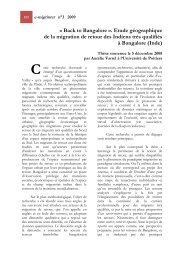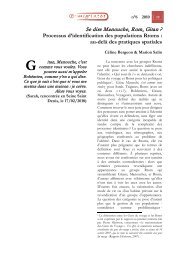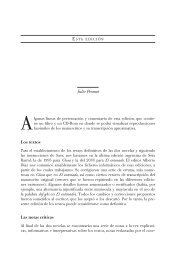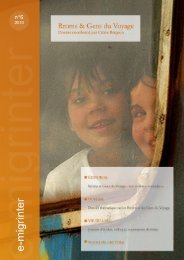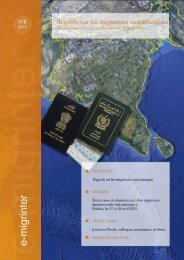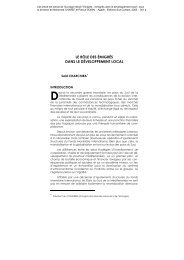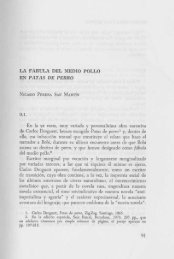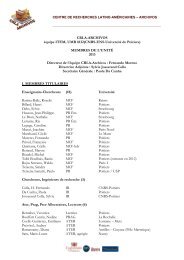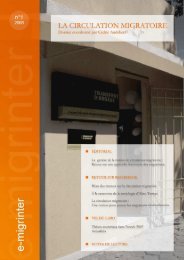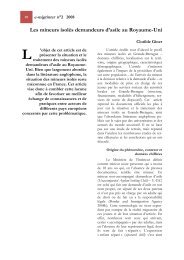e-migrinter 2010 numéro 05 - Maison des Sciences de l'Homme et ...
e-migrinter 2010 numéro 05 - Maison des Sciences de l'Homme et ...
e-migrinter 2010 numéro 05 - Maison des Sciences de l'Homme et ...
Create successful ePaper yourself
Turn your PDF publications into a flip-book with our unique Google optimized e-Paper software.
n°5 <strong>2010</strong> 39<br />
plant, an aluminum smelter and a number of<br />
new buildings in the capital area, men began<br />
to arrive in greater numbers so that women<br />
were no longer the majority of foreign<br />
citizens in the country in 2004. Many<br />
workers stayed only temporarily and did not<br />
renew their work permits, and some<br />
construction laborers worked for foreign<br />
subcontractors only on particular job<br />
assignments. A large majority of the people<br />
who have been moving to Iceland in recent<br />
years can thus be said to be labor migrants.<br />
This is reflected by the fact that in 2007, 9%<br />
of the work force in Iceland had foreign<br />
citizenship and most migrants fell in the age<br />
range from 19 to 39 years old. Meanwhile,<br />
children with foreign citizenship account for<br />
merely 2% of all children and the percentage<br />
of el<strong>de</strong>rly people with foreign citizenship is a<br />
little lower (Iceland Statistics, 2009).<br />
Unlike other North European<br />
countries there are very few refugees in<br />
Iceland and only 510 individuals have been<br />
accepted as quota refugees into the country<br />
since 1956 (Félags- og<br />
tryggingamálaráðuneytið 2009). Until 2003<br />
the largest groups of people who came to<br />
Iceland on the basis of such temporary<br />
workpermits were from Poland, the<br />
Philippines and Thailand. The temporary<br />
permits, which had to be renewed yearly,<br />
were held by the employer. After three years<br />
of working for the same employer, the<br />
employee was able to apply for a permanent<br />
work permit. Since 2004 people from the<br />
European Union and the European<br />
Economic Area have been given priority on<br />
the labor mark<strong>et</strong>, and since 2006 they are no<br />
longer required to apply for a work permit in<br />
Iceland. They have the right to seek labor<br />
for three months after entering the country.<br />
People from countries outsi<strong>de</strong> Europe still<br />
nead a work permit before entering the<br />
country, and this has become particularly<br />
difficult to obtain many have in fact s<strong>et</strong>tled<br />
in Iceland.<br />
Work life<br />
A Filipino woman in her late twenties,<br />
who had compl<strong>et</strong>ed an education as an<br />
economist, got a job in fish processing<br />
through a friend and arrived in Iceland in<br />
2000. After three years in a rural fish plant,<br />
she received a permanent work and<br />
resi<strong>de</strong>nce permit and got a job in a<br />
restaurant. She shares an apartment with a<br />
few friends of her from the Philippines. She<br />
has taken Icelandic courses, but since she<br />
has not worked with Icelan<strong>de</strong>rs in either of<br />
her work places she has not had much of an<br />
opportunity to speak the language. In spite<br />
of not being able to use her education, she<br />
talked about how lucky she is to work in<br />
Iceland compared to her possibilities in the<br />
Philippines; she said she was glad to be able<br />
to send money back to her parents and<br />
siblings. After eight years in Iceland, she says<br />
she has not y<strong>et</strong> <strong>de</strong>ci<strong>de</strong>d how long she will<br />
stay in Iceland, but she is hoping to be able<br />
to move to an English speaking country in<br />
the future.<br />
The migration from the Philippines<br />
began with a few Filipino women moving to<br />
Iceland to marry Icelandic men in the 1980s<br />
and early 1990s. Thus they were the first to<br />
arrive, and some of them have become key<br />
players in the migration chain that has<br />
followed. The population of Filipinos grew<br />
slowly in the 1990s, but in the last <strong>de</strong>ca<strong>de</strong><br />
the number of native born Filipinos living in<br />
Iceland has tripled (Statistics Iceland 2009).<br />
As with other migrant groups, most of the<br />
people who have moved to Iceland from the<br />
Philippines were in their twenties or thi<strong>et</strong>ies<br />
and there have been more women than men.<br />
However, although the number of men has<br />
increased in recent years (as in other migrant<br />
groups), women are still twice as numerous<br />
as men in all age groups except for that<br />
un<strong>de</strong>r the age of 19 (Statistics Iceland 2009).<br />
Incorporation into the labor mark<strong>et</strong> is<br />
often emphasized in discussions of migrants’<br />
integration into a new soci<strong>et</strong>y (Alba and Nee<br />
1997; Esser 2004). Most of the people from



